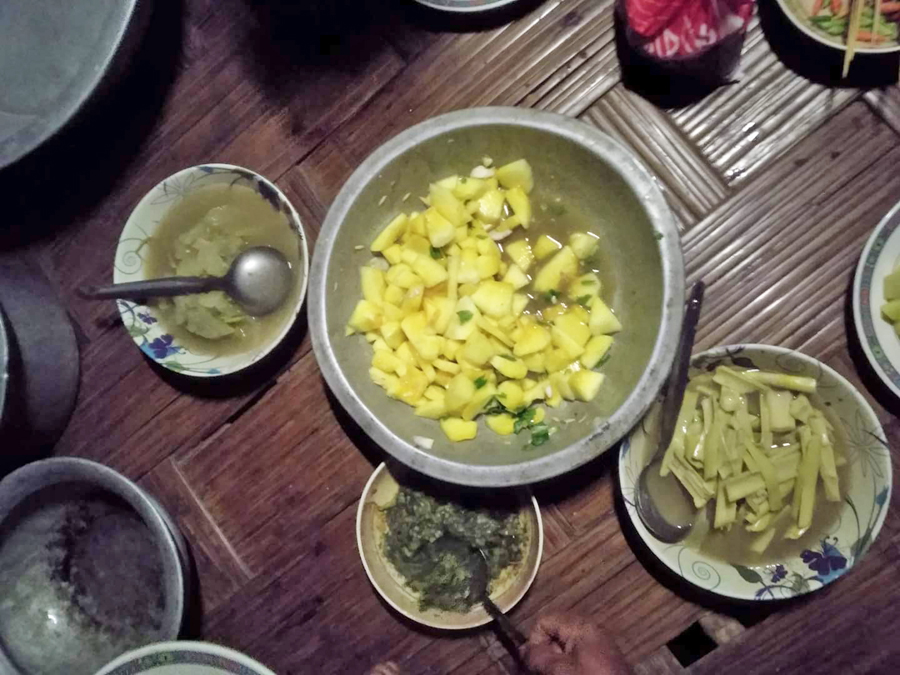Deep into the lesser visited areas of the Chimbuk range, Bandarban, there sits a locality where food, water, and even sanitation facilities are scarce, yet the residents live self-sufficient lives.
The little hamlet in discussion is home to a mere 27 households of some fifty thousand people of the Mro ethnic minority living in Bangladesh. Most of them speak little to no Bangla and live mostly reliant on the forest even today.
This is the story of the secluded village of the Mro ethnic minority, the Mro Paara.
The landscape around the village is not much different from that of other areas of Bandarban high ground adorned with lush greenery with cavernous trenches here and there.
The ambience is eerily quiet, something that our city life, with all of its clamour, can rarely offer. Mobile networks and internet connections are there but frail, and that's good because a dying battery might mean disaster as there is no electricity.

The nights are lively with sounds of gusty wind howling and wild bore snorting all around the place and might seem unearthly beautiful to a Dhaka dweller because the sight of a star-studded clear night sky without any trace of light pollution is a luxury that Dhaka skies cannot provide, just like the calming quietness.
The houses here are not distinguishable from other ethnic communities - bamboo-made houses perched high on sturdy wooden beams. The houses have 1-3 rooms at best, with one or two balcony-like extensions that can be used as a kitchen, storage for firewood, or just a spot to smoke and gossip with neighbours during leisure hours.
A portion of the room or the extensions with a wood burner work as a kitchen while the single community toilet present or the bushes work as the latter. This has been the living conditions of these simple, peace-loving people for decades.

The houses cannot support a lot of weight. Thus, there is only room for the essentials. A mattress on the floor serves as a queen-sized bed, a small rack holding accessories hung beside the mirror works just fine as a dressing table, a rope hung inside the room is their wardrobe and a hollowed bamboo shaft. A thick wooden stick is a functional mortar pestle for the spices and banana leaves for plates - their dependency on nature is visible, and their lifestyle is practically minimalistic.
— Photos by the writer
Speaking of clothes, Mros were known for minimal dressing practices, with both the men and women keeping the upper half of their bodies bare. But things have changed with the rise in popularity of a new religion named Krama, which has its own guidelines for dressing and hair styling.
Lungi, shirts, t-shirts, and jeans are common among young and middle-aged Mro men, with the older generation still holding onto their traditional one-part lower garment.

However, Mro women do not show many traces of modern fashion in their attire; most of them wear the two-piece thami-like dresses found among other ethnic communities. The Mro have a distinctive culture of wearing many traditional and uniquely designed silverware jewellery, but this practice is losing its appeal among the younger generation.
Regarding food, the Mro depend on nature and the animals they can rear at home. The most abundant blessing of nature there is the super sweet papaya of the hills, followed by banana, sweet corn, and ananas in season.
Sources of protein are thin and, thus, expensive. A few keep hens and cows as domestic animals, but the most common animal is perhaps bores, the favourite meat choice for any community function.
Smoking is common among Mro men and women, which is said to help them fight fatigue during their laborious walks up and down the hills. They acquire the items their little community cannot make themselves, like utensils from the nearest bazaar, with the little income they make from selling crops and animals or day labouring.
The steep roads mean heavy vehicles are not safe for usage, and motorbikes are the only alternative available for transporting people and goods.
Mro people are not used to socialising with people from outside their community, so much so that when this writer and their 5 member group of Bengalis reached Mro para, curious children and women gathered around to see them. Both Mro men and women are pleasantly shy, especially with people outside their ethnicity.
One would seldom find a Mro man look outsider women in the eye even when interacting with them but would often find a bunch of Mro women chit-chatting with a group of Mro men in their vicinity. Yet the same women flash and blush red if even a Bengali woman waves at them. The way ethnic culture and tribal lifestyle shape inter and intra gender-dynamics is truly interesting to observe.
One might not find much difference in the lifestyle and living conditions of the Mro with those of other ethnic communities of the country, but the distinction with our life is clear to the eyes. A consumerist lifestyle means we are constantly prodded to want more without being given a chance to contemplate whether we need more. A sneak into the minimalistic yet self-sufficient lifestyle of the Mro people can open our eyes to how much less we can do with and rethink our never-ending demands.
Mro Para, by no means, is a tourist attraction, and the reserved community prefers to keep their life to themselves. Therefore, a visit to their area is only suggested under the management of someone who speaks their tongue and is familiar with and well-accepted among the locals of Mro Paara.
tasnimninny22@gmail.com